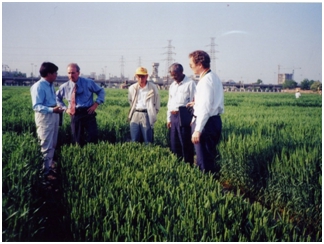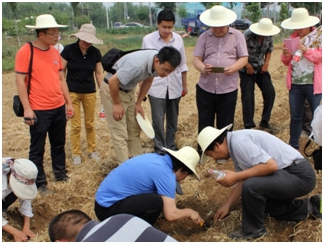分享到
ICS Scientists Achieved Three Second-Class National Science and Technology Progress Awards in 2015
Scientists from Institute of Crop Science (ICS) achieved three second-class National Science and Technology Progress Awards in 2015. They are Introduction and Utilization of CIMMYT Wheat Resources in China by He Zhonghu’s team, Research and Application on Canopy-topsoil Optimization Technology System of High Yeld for Maize by Zhao Ming’s team and Maize Planting Handbooks and Flip Charts by Li Shaokun’s team. The awarding ceremony was held in the Great Hall of the People.
Introduction and Utilization of CIMMYT Wheat in China was led by the Institute of Crop Science, CAAS, and participated by other six provincial agricultural academies in Sichuan, Xinjiang, Yunnan, Gansu, Ningxia and Hubei. CIMMYT and China started collaboration in the early 1970s, while using shuttle breeding to improve wheat disease resistance in the mid 1980s. More than 20 Chinese institutes have been involved in the germplasm exchange and training. CIMMYT germplasm contributing about 7% of the genetic material in Chinese wheat varieties during the past three decades. The figure increased to about 9% in recent years. More than 26% of all major wheat varieties released in China since 2000 contain CIMMYT germplasm. CIMMYT germplasm has contributed higher yield potential, rust resistance, and better quality to Chinese wheat. From 3.8 million to 10.7 million tons of added wheat grain worth between US$ 1.2 billion and US$ 3.4 billion (based on 2011 prices) have been produced thanks to the contributions of CIMMYT germplasm, as reported in “Impact of CIMMYT Wheat Germplasm on Wheat Productivity in China” authored by Jikun Huang and his colleagues at the Center for Chinese Agricultural Policy of the Chinese Academy of Science (CAS).

In order to resolve plant lodging and premature senescence for close planting maize, Zhao Ming’s team established the canopy-topsoil optimization technology system, which aimed at the synchronous optimization of canopy and topsoil, and innovated three key technologies, "three modify-subsoiling", "three resist-chemic regulating”, and “three adjust-dense planting”. The team also integrated key techmologies and built a high efficiency model featuring "deep layer vs dense canopy", "control plant type vs promoting the root", and "improving soil fertility vs high fertilizer effeciency". These technologies and application model were listed as one of the main technologies for MOA and others anthorities.

Introduction and Utilization of CIMMYT Wheat in China was led by the Institute of Crop Science, CAAS, and participated by other six provincial agricultural academies in Sichuan, Xinjiang, Yunnan, Gansu, Ningxia and Hubei. CIMMYT and China started collaboration in the early 1970s, while using shuttle breeding to improve wheat disease resistance in the mid 1980s. More than 20 Chinese institutes have been involved in the germplasm exchange and training. CIMMYT germplasm contributing about 7% of the genetic material in Chinese wheat varieties during the past three decades. The figure increased to about 9% in recent years. More than 26% of all major wheat varieties released in China since 2000 contain CIMMYT germplasm. CIMMYT germplasm has contributed higher yield potential, rust resistance, and better quality to Chinese wheat. From 3.8 million to 10.7 million tons of added wheat grain worth between US$ 1.2 billion and US$ 3.4 billion (based on 2011 prices) have been produced thanks to the contributions of CIMMYT germplasm, as reported in “Impact of CIMMYT Wheat Germplasm on Wheat Productivity in China” authored by Jikun Huang and his colleagues at the Center for Chinese Agricultural Policy of the Chinese Academy of Science (CAS).


Maize Planting Handbooks and Flip Charts were compiled by a large team of hundreds of maize experts.The project is led by Prof. Li Shaokun, chief scientist of crop cultivation and physiology innovation team in Institute of Crop Science, CAAS. More than 500 maize experts from different maize production regions in China participated in editing 6 handbooks and 30 flip charts, based on the natural and ecological characteristics of different regions. The core of the work is the new ideas and technologies for modern maize production. By the end of Dec. 2014, these handbooks have been reprinted 21 times for 910,000 copies, and the flip charts 16 times for 1654,000 copies. They are translated into Monglian, Uygur, Kazak and so on. Maize Planting Handbook in Southwest was also translated into English and used as agricultural exchange and training book for Southeast Asia and Africa. These handbooks and flip charts have played a great role in all the maize production regions.
Latest News
-
 Apr 18, 2024Opening Ceremony of the Training Workshop on Wheat Head Scab Resistance Breeding and Pest Control in Africa Held in CAAS
Apr 18, 2024Opening Ceremony of the Training Workshop on Wheat Head Scab Resistance Breeding and Pest Control in Africa Held in CAAS -
 Apr 03, 2024IPPCAAS Co-organized the Training Workshop on Management and Application of Biopesticides in Nepal
Apr 03, 2024IPPCAAS Co-organized the Training Workshop on Management and Application of Biopesticides in Nepal -
 Mar 28, 2024Delegation from the School of Agriculture and Food Science of University College Dublin, Ireland Visit to IAS, CAAS
Mar 28, 2024Delegation from the School of Agriculture and Food Science of University College Dublin, Ireland Visit to IAS, CAAS -
 Mar 25, 2024Director of World Food Prize Foundation visited GSCAAS
Mar 25, 2024Director of World Food Prize Foundation visited GSCAAS -
 Mar 20, 2024Institute of Crop Sciences (ICS) and Syngenta Group Global Seeds Advance Collaborative Research in the Seed Industry
Mar 20, 2024Institute of Crop Sciences (ICS) and Syngenta Group Global Seeds Advance Collaborative Research in the Seed Industry
